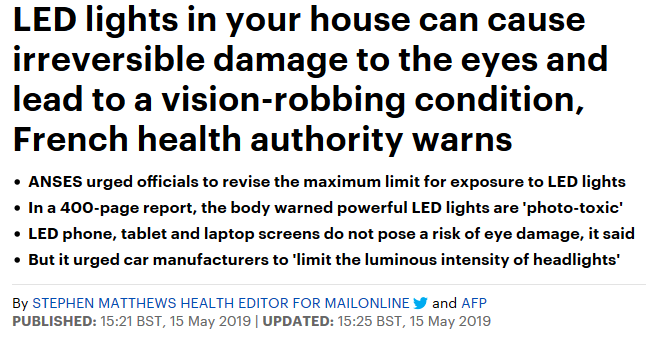Of course, any high intensity light source is potentially damaging to the retina; that’s why we should not look directly at the sun or try to view a solar eclipse directly. Electric arc welding and lasers — including laser pointers — are also hazardous. Retinal burns are painless and permanent. It is believed that that is how Galileo went blind, looking at the sun too much.
So, obviously LED’s that are high intensity come with the automatic warning about any high intensity light source. However, white light LED technology is based on a blue or UV LED with a phosphor that fluoresces with the missing colours to make white, i.e. red and green. Under addition of light, red and green make yellow. It turns out that, according to a Daily Mail report on a French Government study, excess blue light may interfere with Melatonin, thus disrupting the day/night sleep cycle:

In discussing the blue light problem, the article commented:
LED phone, tablet and laptop screens do not pose a risk of eye damage, Francine Behar-Cohen, an ophthalmologist, said.
He explained they have a lower risk because their luminosity is very low compared to other types of lighting.
But these back-lit devices – especially when they are used at night or in a dark setting – can ‘disturb biological rhythms, and thus sleep patterns’.
Because the crystalline lens in their eyes are not fully formed, children are particularly susceptible to such disruptions, the ANSES noted.
Interfering with the body’s circadian rhythm is also known to aggravate metabolic disorders such a diabetes, as well as cardiovascular disease and some forms of cancer, noted Dina Attia, a researcher and project manager at ANSES.
In addition, a stroboscopic affect in some LED lights – provoked by tiny fluctuations in electric current – can induce ‘headaches, visual fatigue and a higher risk of accidents,’ the report said.
For domestic lighting, ANSES recommended buying ‘warm white’ LED lighting, limiting exposure to LED sources with a high concentration of blue light, and avoiding LED screens before bedtime.
It also noted that:
The report distinguished between acute exposure of high-intensity LED light, and ‘chronic exposure’ to lower intensity sources.
While less dangerous, even chronic exposure can ‘accelerate the ageing of retinal tissue’ and contribute to poor vision, the agency said.
So, we are duly warned to be careful — e.g. the background lighting for this task is LED and the screen is LED backlit, so it is a really common problem. END